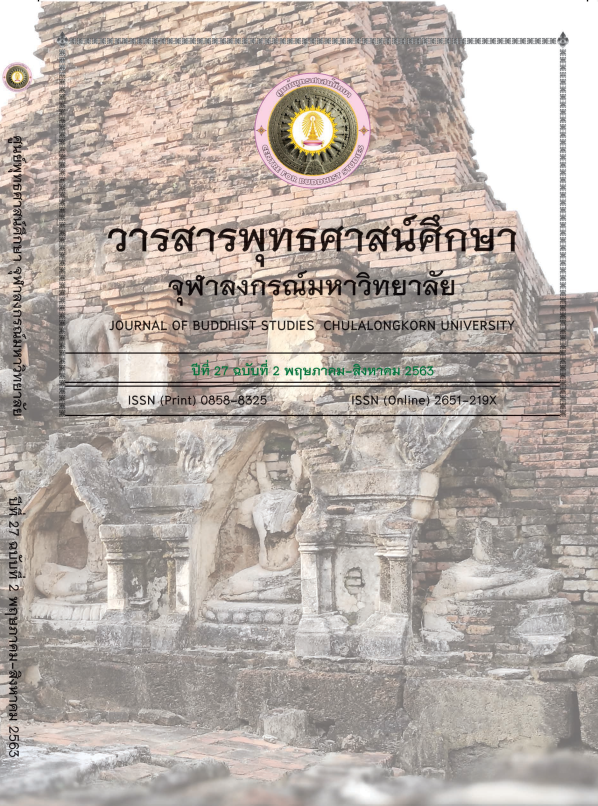Deconstructing History of The Schisms of Early Buddhism and An Alternative Way to Understand Theravada and Mahasamghika School
Keywords:
Schisms, Theravada Buddhism, Mahasamghika, Cultural PluralismAbstract
The objectives of this research are threefold: (1) to re-visit the schisms in Indian Buddhism during the 1st and 3rd Buddhist Centuries (543-200 B.C.) and the traditional accusations against the Mahasamghika and other schools as appeared in the Pali texts (the Tipitaka, Atthakathas, and Dipavamsa) of Theravada Buddhism; (2) to deconstruct the accusation that the Mahasamghika School was the origin of debilitated discipline and chasms among the Sangha after the passing away of the Buddha; and (3) to present a possible alternative to the way Theravada Buddhist identity has been constructed in Thai society. This possible alternative is inspired by a conversation with the multiculturalist position of Charles Taylor.
Evidence from the 1st and 3rd centuries on this issue indicate that the traditional accusation may not be true without contestations. Traditional accusations indicate that the Mahasamghika was the cause of chasms, violated the Dhamma-Vinaya as compiled in the First Councils, was an enemy of Buddhism, and brought the decline and corruption to Buddhism. If the evidence and analysis from this study is well worth consideration, the longstanding beliefs that Theravada Buddhists are the only ones to maintain the pure Dhamma-Vinaya as compiled in the First Councils could be subjected to a re-evaluation.
Downloads
References
กรมศิลปากร. (2557). พระคัมภีร์ทีปวงศ์ : ตำนานว่าด้วยการประดิษฐานพระพุทธศาสนาในลังกาทวีป (ปุ้ย แสงฉาย, ผู้แปล). พิมพ์ครั้งที่ 2. กรุงเทพฯ : สำนักวรรณกรรมและประวัติศาสตร์ กรมศิลาปากร.
คณาจารย์มหาจุฬาลงกรณราชวิทยาลัย ในพระบรมราชูปถัมภ์. (2552). ประวัติศาสตร์พระพุทธศาสนา. กรุงเทพฯ: มหาจุฬาลงกรณราชวิทยาลัย.
คอนซ์, เอดเวิร์ด. (2552). พุทธศาสนา สาระและพัฒนาการ. (นิธิ เอียวศรีวงศ์ ผู้แปล). พิมพ์ครั้งที่ 3. กรุงเทพฯ: มติชน.
ชาซิกุ, ซาซากิ. (2560). “วิธีเขียนแผนภาพการแตก 18 นิกาย” ธรรมธารา วารสารวิชาการทางพระพุทธศาสนา, 3(1),127-162.
ชาญณรงค์ บุญหนุน. (2543). “การสังคายนาในมุมมองใหม่ หนทางสู่การแก้ปัญหาคณะสงฆ์ไทยปัจจุบัน” วารสารพุทธศาสน์ศึกษา จุฬาลงกรณ์มหาวิทยาลัย, 7(2), 5-29.
ซิว ซุหลุน. (2547). ถังซำจั๋ง จดหมายเหตุการเดินทางสู่ดินแดนตะวันตกของมหาราชวงศ์ถัง. กรุงเทพฯ : มติชน.
บรรเจิด ชวลิตเรืองฤทธิ์. (2558). “เถรวาทกับหินยานต่างกันอย่างไร” ธรรมธารา วารสารวิชาการทางพระพุทธศาสนา, 1(1), 55-96.
พระธรรมปิฎก (ป.อ.ปยุตฺโต). (2543). รู้จักพระไตรปิฎกเพื่อเป็นชาวพุทธที่แท้. กรุงเทพฯ: มูลนิธิพุทธธรรม.
พระธรรมปิฎก (ป.อ.ปยุตฺโต). (2544). ทัศนะของพระพุทธศาสนาต่อสตรีและการบวชเป็นภิกษุณี. พิมพ์ครั้งที่ 4. กรุงเทพฯ: สำนักพิมพ์สุขภาพใจ.
พระมหาสมชาย ฐานวุฑฺโฒ. (2558). “สิกขาบทในพระปาฏิโมกข์เกิดขึ้นเมื่อใด” ธรรมธารา วารสารวิชาการทางพระพุทธศาสนา, 1(1), 13-54.
พระโสภณคณาภรณ์ (ระแบบ ฐิตญาโณ). (2529). ประวัติศาสตร์พระพุทธศาสนา. กรุงเทพฯ: กองทุนไตรรัตนานุภาพ.
มหาจุฬาลงกรณราชวิทยาลัย ในพระบรมราชูปถัมภ์. (2539). พระไตรปิฎกภาษาไทย ฉบับมหาจุฬาลงกรณราชวิทยาลัย. เล่ม 7, 37. กรุงเทพฯ: มหาจุฬาลงกรณราชวิทยาลัย.
มหามุกฎราชวิทยาลัย ในพระบรมราชูปถัมภ์. (2525ก). พระวินัยปิฎก เล่มที่ 1 ภาคที่ 1 มหาวิภังค์ ปฐมภาคและอรรถกถา. กรุงเทพฯ: โรงพิมพ์มหามกุฎราชวิทยาลัย.
มหามุกฎราชวิทยาลัย ในพระบรมราชูปถัมภ์. (2525ข). พระอภิธรรมปิฎก เล่มที่ 4 กถาวัตถุ ภาคที่ 1 และอรรถกถา. กรุงเทพฯ: โรงพิมพ์มหามกุฎราชวิทยาลัย.
เมธี พิทักษ์ธีระธรรม. (2559). “Samayabhedoparacnacakra: คำแปลพร้อมเชิงอรรถวิเคราะห์ (1)” ธรรมธารา วารสารวิชาการทางพระพุทธศาสนา, 2(1), 67-103.
เมตฺตานนฺโท ภิกฺขุ. (2545). เหตุเกิด พ.ศ.1 เล่ม 2 วิเคราะห์กรณีปฐมสังคายนาและภิกษุณีสงฆ์. กรุงเทพฯ: สำนักพิมพ์พระอาทิตย์.
ทองย้อย แสงสินชัย. (2546). เหตุเกิดเมื่อพ.ศ.2545 เล่ม 2. กรุงเทพฯ: มูลนิธิพุทธธรรม.
สุวรรณา สถาอานันท์. (2550). ศรัทธากับปัญญา : บทสนทนาทางปรัชญาว่าด้วยศาสนา. กรุงเทพฯ: สำนักพิมพ์แห่งจุฬาลงกรณ์มหาวิทยาลัย.
สิริวัฒน์ คำวันสา. (2523). พุทธศาสนาในอินเดีย. กรุงเทพฯ: กรุงสยามการพิมพ์.
เสถียร โพธินันทะ. (2544). ประวัติศาสตร์พระพุทธศาสนา. พิมพ์ครั้งที่ 5. กรุงเทพฯ: สร้างสรรค์บุ๊คส์.
อภิชัย โพธิ์ประสิทธิ์ศาสต์. (2551). พระพุทธศาสนามหายาน. พิมพ์ครั้งที่ 1. กรุงเทพฯ: สำนักพิมพ์แห่งจุฬาลงกรณ์มหาวิทยาลัย.
Clarke, Shayne, (2012). “Vinaya.” in Sikl, Jonathan A., et, al.(ed). Brill’s Encyclopedia of Buddhism (60-68). The Natherlands: Leiden Brill.
Cousins, L. S., (2012). “The Teachings of the Abhayagiri School.” Skilling, Peter. et, al.(ed), (2012). How Theravada is Theravada? Exploring Buddhist Identities (67-127). Thailand: Silkworm Books.
Dutt, Sukumar. (1962). Buddhist Monks and Monasteries in India: Their History and Their Contribution to Indian Culture. Delhi: Motilal Banarsidas Publishers.
Gethin, Rupert. (2012). “Was Buddhaghosa a Theravadin? Buddhist Identity in the Pali Commentaries and Chronicles.” Skilling, Peter. et, al.(ed), 2012. How Theravada is Theravada? Exploring Buddhist Identities (1-61). Thailand: Silkworm Books.
Gombrich, Richard F.. (2006).Theravada Buddhism: A Social History from Ancient Banares to Modern Columbo. London: Routledge.
Hick, John. (1985). Problems of Religious Pluralism. U.K.: Palgrave Macmillan.
Nattier, Janice J. and Prebish, Charles S.. (1977). "Mahāsāṃghika Origins: The Beginnings of Buddhist Sectarianism," History of Religions, 16(3), 237-272.
Skilling, Peter. et, al.(ed). (2012). How Theravada is Theravada? Exploring Buddhist Identities. Thailand: Silkworm Books.
Taylor, Charles. (1994). Multiculturalism: Examining the Politics of Recognition. Edited and introduced by Amy Gutmann. U.K.: Princeton University Press.
Downloads
Published
How to Cite
Issue
Section
License
บทความที่ได้รับการตีพิมพ์เป็นลิขสิทธิ์ของศูนย์พุทธศาสน์ จุฬาลงกรณ์มหาวิทยาลัย
ข้อความที่ปรากฏในบทความแต่ละเรื่องในวารสารวิชาการเล่มนี้เป็นความคิดเห็นส่วนตัวของผู้เขียนแต่ละท่านไม่เกี่ยวข้องกับศูนย์พุทธศาสน์ จุฬาลงกรณ์มหาวิทยาลัย และคณาจารย์ท่านอื่นๆในมหาวิทยาลัยฯ แต่อย่างใด ความรับผิดชอบองค์ประกอบทั้งหมดของบทความแต่ละเรื่องเป็นของผู้เขียนแต่ละท่าน หากมีความผิดพลาดใดๆ ผู้เขียนแต่ละท่านจะรับผิดชอบบทความของตนเองแต่ผู้เดียว






